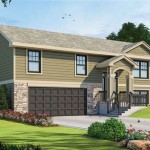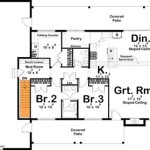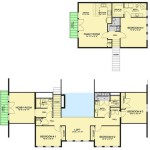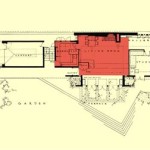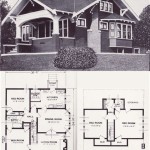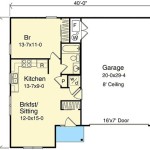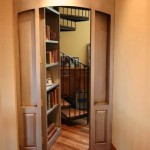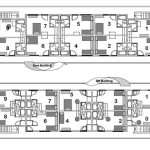One-Story Tudor House Plans: A Comprehensive Guide
The Tudor architectural style, originating in England between 1485 and 1603, evokes a sense of history, charm, and timeless elegance. While traditionally associated with larger, multi-story homes, the essence of Tudor design can be seamlessly adapted to single-story residences. One-story Tudor house plans offer a unique blend of historical aesthetics and modern convenience, making them an appealing option for those seeking a distinctive and functional living space. This article provides a detailed overview of one-story Tudor house plans, exploring their key characteristics, design considerations, and the advantages they offer.
Tudor architecture is characterized by several distinctive elements. Steeply pitched roofs, often with multiple gables, are a hallmark feature. Decorative half-timbering, typically consisting of exposed wood framing with contrasting infill materials such as stucco or brick, is another prominent characteristic. Tall, narrow windows, often arranged in groups or with diamond-shaped panes, contribute to the style's visual appeal. Large, prominent chimneys, sometimes adorned with decorative brickwork, further enhance the Tudor aesthetic. Arched doorways, occasionally featuring a hint of Gothic influence, provide an inviting entrance. Replicating these elements in a one-story design requires careful planning and a nuanced understanding of the style's fundamental principles.
Key Features of One-Story Tudor House Plans
Successfully translating Tudor elements into a single-story format requires a thoughtful approach to design. While the absence of multiple stories might initially seem limiting, it presents opportunities to emphasize horizontal lines and create a more expansive feel. Several key features are commonly incorporated into these plans.
The roof design is paramount. Maintaining a steeply pitched roof is crucial to capturing the Tudor aesthetic. Multiple gables, even if smaller in scale, can add visual interest and break up the horizontal expanse of the roofline. Consider incorporating dormers to provide additional light and ventilation to interior spaces. The roofing material itself can contribute to the overall look. Slate or simulated slate shingles are excellent choices, evoking the traditional materials used in Tudor architecture.
Half-timbering is another essential element. On a single-story home, careful consideration should be given to the placement and proportion of the timber detailing. Overuse can make the house appear cluttered or disproportionate. Strategically placed timbering, particularly around gables, windows, and entryways, can effectively capture the Tudor spirit without overwhelming the design. The color and texture of the infill material (stucco, brick, or stone) should complement the timbering to create a cohesive and visually appealing facade.
Window design is also crucial. Tall, narrow windows are characteristic of Tudor architecture. While maintaining the narrow profile can be challenging in a single-story design without sacrificing natural light, maximizing window height and using vertical mullions can help achieve the desired effect. Grouping windows together, or incorporating bay windows, can also add architectural interest and enhance the entry of natural light. Diamond-shaped panes, although traditionally associated with Tudor windows, can be incorporated as accents or in specific areas to add a touch of historical authenticity.
The entry points are important in every house plan. Creating a welcoming and prominent entryway is essential. An arched doorway, possibly recessed and embellished with stone accents, can create a focal point that draws the eye. A covered porch or portico, featuring timber detailing or stone supports, can further enhance the entry's visual appeal and provide shelter from the elements. The front door itself should be chosen to complement the Tudor style, such as a solid wood door with wrought-iron hardware.
Exterior materials play a vital role in creating the desired aesthetic. A combination of materials, such as stucco, brick, and stone, can add texture and depth to the facade. The color palette should be carefully considered to evoke the earthy tones and natural materials typically associated with Tudor architecture. Browns, creams, and grays are common choices, often accented with darker shades to highlight the timber framing. Landscaping can also contribute to the overall Tudor aesthetic. Formal gardens, featuring clipped hedges, stone pathways, and traditional plantings, can complement the architecture and create a cohesive and inviting outdoor space.
Interior Design Considerations for One-Story Tudor Homes
While the exterior of a one-story Tudor house should reflect the historical style, the interior can be adapted to suit modern living preferences. The layout should be functional and efficient, maximizing space and flow. Several design elements can be incorporated to enhance the Tudor aesthetic while maintaining a comfortable and contemporary living environment.
Exposed beams are a signature element of Tudor interiors. While replicating the massive timber beams found in traditional Tudor homes may not be practical in a single-story design, incorporating decorative beams, either structural or non-structural, can add a touch of rustic charm and create a sense of character. The beams can be stained or painted to complement the overall color scheme.
Fireplaces are often a focal point in Tudor interiors. A large, stone fireplace in the living room can create a warm and inviting atmosphere. The fireplace surround can be adorned with intricate carvings or tilework to enhance its visual appeal. Consider incorporating a wood-burning stove for added warmth and ambiance. A smaller fireplace can also be used in the master bedroom for a touch of luxury.
Wood flooring is a common choice for Tudor-style homes. Wide-plank hardwood flooring in a natural finish can create a sense of warmth and authenticity. Stone or tile flooring can be used in areas such as the kitchen and bathrooms for added durability and visual interest. Consider incorporating area rugs to add color and texture to the floors.
Lighting fixtures should be chosen to complement the Tudor style. Wrought-iron chandeliers and sconces can add a touch of historical charm. Dimmer switches can be used to control the lighting levels and create a warm and inviting ambiance. Consider incorporating natural light through large windows and skylights to enhance the interior spaces.
The color palette for Tudor interiors should be inspired by nature. Earthy tones, such as browns, greens, and creams, are common choices. Darker shades can be used as accents to highlight architectural details. Consider incorporating pops of color through artwork, fabrics, and accessories. The furniture should be comfortable and functional, with a focus on natural materials such as wood, leather, and linen.
Advantages of One-Story Tudor House Plans
Opting for a one-story Tudor house plan offers several advantages, combining the aesthetic appeal of Tudor architecture with the practicality of single-level living.
Accessibility is a primary benefit. Single-story homes eliminate the need for stairs, making them ideal for individuals with mobility issues, families with young children, and older adults seeking to age in place. This accessibility can significantly enhance the quality of life and provide greater independence.
Open floor plans are often easier to achieve in a single-story design. Without the constraints of supporting walls and load-bearing structures associated with multiple stories, creating a seamless flow between living spaces becomes more straightforward. This can result in a more spacious and airy feel, conducive to modern living and entertaining.
Maintenance is generally easier with a one-story home. Exterior maintenance tasks, such as cleaning gutters or painting trim, are simplified compared to multi-story houses. The absence of second-story windows eliminates the need for ladders or scaffolding, making maintenance safer and more convenient.
Heating and cooling can be more efficient in a single-story home. With less vertical space to heat or cool, energy consumption can be reduced. Properly insulated attics and efficient HVAC systems can further enhance energy efficiency. Consider installing radiant floor heating for added comfort and energy savings.
Construction costs can sometimes be lower for a one-story home compared to a multi-story house of the same square footage. The absence of complex structural elements and the simplified construction process can potentially reduce labor and material costs. However, this depends on the complexity of the Tudor design and the specific site conditions.
The architectural style of a one-story Tudor house plan offers a unique aesthetic that stands apart from more conventional designs. The combination of historical charm and modern convenience makes it an appealing option for those seeking a distinctive and functional living space.

House Plan 42679 Tudor Style With 2341 Sq Ft 4 Bed 3 Bath

Plan 43805 Tudor Style With 3 Bed Bath Car Garage

House Plan 73370 Tudor Style With 3095 Sq Ft 3 Bed 2 Bath 1

Tudor House Plans Modern Historic English Floor

33 Best Tudor House Plans Ideas

Tudor Style House Plans

One Level Tudor Home Plan

House Plan 51689 Tudor Style With 2066 Sq Ft 3 Bed Bath 1

Modern English Tudor Elite Design Group

One Story European Style House Plan 9977 Crescent
See Also

